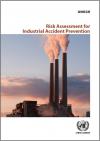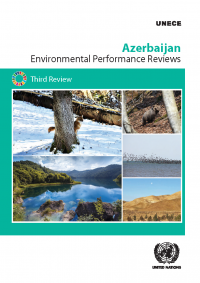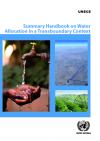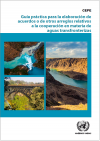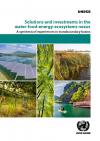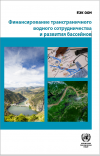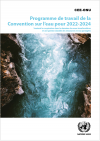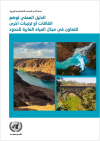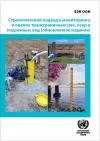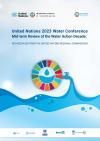Publications
Displaying Results 1 - 20 of 935
- English
Most of the world’s water resources are shared between countries. These transboundary waters create social, economic, environmental and political interdependencies that make cooperation a precondition to sustainable development and peace. SDG indicator 6.5.2 measures cooperation on both transboundary river and lake basins, and transboundary aquifers.
The
- English
Most of the world’s freshwater sources are shared between two or more countries. These transboundary waters face significant pressures due to population growth, increasing water demand and the impacts of the triple-planetary crisis of climate change, pollution and biodiversity loss. The sharing of data and information across different levels as well as political, sectoral, environmental and
- English
The 2023 Edition of the UNECE Guidelines for the Application of Environmental Indicators is available here.
- English
Industrial accidents can have severe effects on people, the environment and economies, causing fatalities, disease outbreaks, injuries, environmental pollution, biodiversity loss, conflicts, political instability, financial loss and more. National governments and international organizations have developed legal and policy instruments and tools to prevent, prepare for and respond to industrial
- English
The second Environmental Performance Review (EPR) of Armenia builds on the substantial experience accumulated by the Economic Commission for Europe (ECE) and its member States in using the EPR tool to regularly assess progress achieved in reconciling national economic and environmental objectives. The second EPR of Armenia takes stock of progress made in the governance and management of the
- English
Download this publication in English.
This report assesses the main ingredients needed to navigate the transition towards agreed nitrogen sustainability targets.
Global nitrogen losses pose a serious threat to environmental sustainability and compromise the ability of the
- English
The third Environmental Performance Review (EPR) of Kyrgyzstan builds on the substantial experience accumulated by the Economic Commission for Europe (ECE) and its member States in using the EPR tool to regularly assess progress achieved in reconciling national economic and environmental objectives. The third EPR of Kyrgyzstan takes stock of progress made in the governance and management of the
- English
The Environmental Performance Review (EPR) of Mauritania builds on the substantial experience accumulated by the Economic Commission for Europe (ECE) and its member States in using the EPR tool to regularly assess progress achieved in reconciling national economic and environmental objectives.
The review covers legal and policy frameworks and compliance assurance mechanisms. It also focuses on
- Français
L’examen de la performance environnementale (EPE) de la Mauritanie s’appuie sur l’expérience substantielle accumulée par la Commission économique pour l’Europe (CEE) et ses États membres dans l’utilisation de cet outil pour évaluer régulièrement les progrès accomplis dans la conciliation des objectifs économiques et environnementaux nationaux.
L’examen porte sur les cadres juridiques et
- English
The third EPR of Azerbaijan takes stock of progress made in the governance and management of the environment since the second review in 2011, assesses the implementation of the recommendations of that review and makes new recommendations for the country to implement. In addition, the third EPR looks into developments related to the country’s attainment of relevant targets of the 2030 Agenda for
- English
This Summary Handbook on Water Allocation in a Transboundary Context (Summary Handbook) contains the key information from the Handbook on Water Allocation in a Transboundary Context (Handbook) adopted by the 9th Meeting of the Parties (MOP9) to the Water Convention in 2021, covering the global practice of transboundary water allocation. It seeks to be a shorter and targeted practical resource for
- English
The Regional Assessment Report on Disaster Risk Reduction 2023 Europe and Central Asia (RAR) was published by the United Nations Office for Disaster Risk Reduction (UNDRR) under the Sendai Framework for Disaster Risk Reduction 2015-2030. It presents analysis of key risk drivers, challenges, opportunities, good practices, and recommendations for disaster risk reduction in Europe and Central Asia.
- Español
La elaboración de arreglos transfronterizos y el establecimiento de órganos conjuntos es una obligación clave para las Partes ribereñas del Convenio sobre la Protección y Utilización de los Cursos de Agua Transfronterizos y de los Lagos Internacionales (“Convenio del Agua de 1992”). Sin embargo, la presentación de informes sobre el Convenio del Agua de 1992 y sobre el indicador 6.5.2 de los ODS,
- Español
Los recursos hídricos y los ecosistemas sustentan el desarrollo socioeconómico en la energía y la agricultura, así como en la industria, el turismo, la navegación y otros sectores. Sin embargo, estos desarrollos también ejercen una presión significativa sobre el medio ambiente, con impactos sobre la disponibilidad y la calidad del agua. Abordar los problemas relacionados con el agua y el medio
- Français
La Convention sur la protection et l’utilisation des cours d’eau transfrontières et des lacs internationaux (Convention sur l’eau), dont le secrétariat est hébergé par la Commission économique des Nations Unies pour l’Europe (CEE-ONU), prescrit aux parties d’élaborer et de mettre en place des programmes communs de surveillance des eaux transfrontières, de procéder à des évaluations communes ou
- Pусский
Более 60% мировых запасов пресной воды сосредоточено в водных бассейнах, простирающихся по территории двух или более прибрежных государств. Устойчивое совместное управление этими трансграничными водными ресурсами имеет решающее значение для обеспечения доступа к водным ресурсам, устойчивого развития, региональной стабильности и мира. Однако многие страны и бассейны сталкиваются с трудностями при
- Français
Supporting transboundary water cooperation and the sustainable management of shared water resources
The Water Convention, which celebrated its 30th anniversary in 2022, is a key legal and intergovernmental framework for promoting transboundary water cooperation and sustainable management of shared water resources that has proven its effectiveness over the past 30 years. The Convention, which
- العربية
إن وضع اتفاقات عابرة للحدود وإنشاء هيئات مشتركة هي من االلتزامات األساسية التي تقع على عاتق
األطراف المتشاطئة التفاقية حماية واستخدام المجاري المائية العابرة للحدود والبحيرات الدولية (“اتفاقية
1992 ”). ومع ذلك، فإن اإلبالغ عن التقدم المحرز في تحقيق اتفاقية المياه لعام1992 المياه لعام
من أهداف التنمية المستدامة، الذي يقيس نسبة مناطق أحواض المياه العابرة للحدود 6-5-2 والمؤشر
التي تربطها ترتيبات
- Pусский
В соответствии с Конвенцией по охране и использованию трансграничных водотоков и международных озер (Конвенция по трансграничным водам), секретариатом которой является Европейская экономическая комиссия
Организации Объединенных Наций (ЕЭК ООН), Стороны должны разрабатывать и осуществлять совместные программы мониторинга состояния трансграничных вод, осуществлять совместно или в координации друг с
- English
The booklet summarizes input from the five United Nations Regional Commissions and UN-Water regional discussion groups to the United Nations 2023 Water Conference. It provides a snapshot of the agreed input from the regional discussions to the global event, reflecting the diversity of views and experiences. It also showcases progress, opportunities and challenges identified in the five regions as



